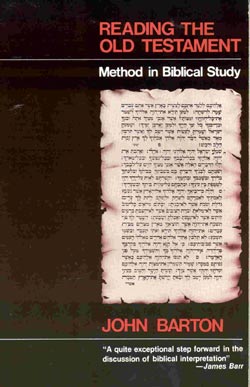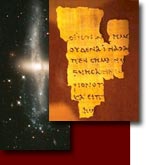| Site Map | Contacts | Links | Newsletter | |
The Bible
Biblical Criticism
Lower Criticism
Textual Criticism
Lower Criticism or Textual Criticism does not mean one hates the text, but it is a technical term. Textual Criticism is the weighing of the evidence for the most likely textual reading. Since the translation of the KJV many ancient manuscripts have been found. The most important has been the Dead Sea Scrolls. Some thought this would prove how different the Bible was, but it showed how accurately it had been preserved. Even in the Dead Sea Scrolls and other ancient manuscripts there are textual differences that must be looked at.
Textual Troubles
There are four main groups of common causes of textual corruption. First there are changes that expand the text. Secondly, there are changes the shorten the text. Thirdly, there are changes that do not add or shorten the text. Finally, there are deliberate changes in the text.
Let us look at reasons for the expansion of the text. (1) Simple additions to the text usually to explain it. This may be done for clarity or emphasis. For example in Joshua 9:24 lk, meaning "all" is added to the text. (2) Dittography which means "double writing." This is seen in Jeremiah 51:3 (draw 2x), and Ezekiel 48:16 (five 2x). The KJV omits these doubles, but leaves the one in Leviticus 20:10. (3) Glosses which are like an explanatory note. One example of a gloss is with obscure or ambiguous place-names like "On" in Jeremiah 43:13 in the LXX. The city of Dan mentioned in Genesis 14:14 must be a gloss. Some cities are just updated with their new name. (4) Explicitation is making the implicit explicit which expands the text. In Genesis 29:25 the LXX adds "Jacob" to show who is speaking. (5) Conflation is the combination of two or (rarely) more readings. This is seen in 2 Samuel 22: 38-9 and 43 when the MT is compared to 4QSama and the LXX.
Secondly, let us look at reasons for the shortening of the text. (1) Haplography which means "single writing" when it should be repeated (Judges 20:13). (2) Parablepsis meaning "oversight" is when a scribe skips over part of the text. An example is Judges 16:13-14 when MT is compared to the LXX. (3) Homoioarkton which means "like beginning" is when a similar beginning of words is skipped over (Genesis 31:18). (4) Homeioteleuton which means "like ending" is when a similar ending is skipped over. An example is in Genesis 4:8 and Leviticus 15:3.
Thirdly, let us look at the reasons for changes in the text that do not change the length of the text. (1) Letters are confused. Since some Hebrew words look very similar, it is easy to confuse them like h for j and d for r (Genesis 10:4). (2) Misdivision of the words sometimes occurs Genesis 49:19-20. (3) Metathesis which is the switching of letters occurs (Leviticus 3:7). (4) Modernization of grammar, spelling and pronunciation occurs. In Isaiah 24:23 the LXX understood different spelling for the same Hebrew words moon/brick and sun/wall.. (5) Prosaizing is when the scribe changes the poetry to prose (Psalm 31:22). (6) Interpretative errors occur with misdivision of verses and misvocalization (Isaiah 7:11).
Lastly, let us look at the reasons for deliberate changes. (1) A scribe deliberately changes one or more letters to disguise the text. In I Samuel 3:13 Eliís sons blaspheme "for themselves" rather than the LXX blaspheme "God" which is too dishonorable. (2) Euphemistic insertions to avoid dishonor (2 Samuel 12:9). (3) Euphemistic substitutions (2 Samuel 2:8). (4) Harmonizing the text (Genesis 2:2). (5) Suppressed readings (I Samuel 13:1). These are some of the things that can happen to a text (for more examples see McCarter 1986).
Higher Criticism
 This is an excellent paperback that covers the different kinds of Biblical Criticism. Reading the Old Testament by John Barton. Published by Westminster Press, 1984. |
Source Criticism
This is an attempt to find the different sources from which the text was composed. The first five books of the Bible are said to be written by Moses yet there seems to be four major underlying sources, JEDP. This theory was first articulated by Julius Wellhausen.
J source uses the name Jehovah, from Judah.
E source uses the name Elohim,from Ephriam.
D source the book of Deuteronomy.
P source from the Priests.
Form Criticism
This has to do with the oral setting from which the texts were written. The setting, sitz im leben, is key to understanding the text. They try to isolate the pre-literary stages of the text, and reconstruct the social life and institutions of Israel. "Form" is from the German Gattung that would be better translated as "genre." The Psalms are seen as liturgical texts for public and official use like others in the ancient world.
The key leaders were Hermann Gunkel followed by Sigmund Mowinckel.
Redaction Criticism
Not only does there seem to be different sources for the text, but also different redactors who complied and edited the texts. The key leader of this type of criticism is Gerhard von Rad as seen in his commentary Genesis.
Canonical Approach
This view lacks criticism, but instead takes the texts as they are, and how they functioned in the community. The key proponent of this theory is B.S. Childs.
Structuralist Criticism
Structuralism or semiotics arises out of the disappointment with the historical-critical methods. It is culture that gives meaning to convention. Meaning is just a function of the structures of the cultural system. For example, a hand shake only has meaning in its cultural context. This theory looks at the mechanisms that give the text meaning. For example, we know that "Once upon a time" at the beginning of a story indicates that it is a fairy tale.
Biblical Structuralism looks for key structures in the Biblical text. The Flood of Genesis 6-9 has a very definite pattern.
New Criticism
New Criticism is the name given to the literary criticism movement during the 1940's and 1950's. Its beginnings can be traced to critics like T.S. Eliot, I.A. Richards, and William Empson.
The main points of New Criticism are:
- The text is an artifact.
- Intentionalism is a fallacy.
- The meaning of the text is its function of its place in the canon.
Deconstructionism
This view posits that one can not real know what the text really means. The text can mean so many different things.
